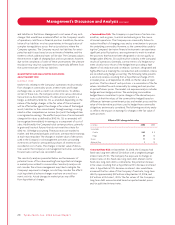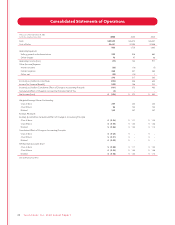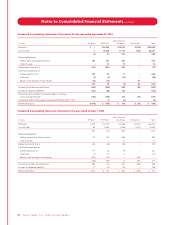Tyson Foods 2006 Annual Report Download - page 30
Download and view the complete annual report
Please find page 30 of the 2006 Tyson Foods annual report below. You can navigate through the pages in the report by either clicking on the pages listed below, or by using the keyword search tool below to find specific information within the annual report.
• Asset Retirement Obligations: In the fourth quarter of fiscal 2006,
the Company adopted Financial Accounting Standards Board (FASB)
Interpretation No. 47, “Accounting for Conditional Asset Retirement
Obligations,” an interpretation of FASB Statement No. 143 (FIN 47),
“Accounting for Asset Retirement Obligations” (SFAS No. 143), which
requires the fair value of a liability for an asset retirement obligation
be recognized in the period in whichit is incurred if a reasonable
estimate of fair value can be made, and associated asset retirement
costs be capitalized as part of the carrying amount of the long-lived
asset. See Note 2, “Change in Accounting Principles” of the Notes
to Consolidated Financial Statements for the impact of the adop-
tion of FIN 47.
• Accrued Self Insurance: The Company uses a combination of
insurance and self-insurance mechanisms to provide for the poten-
tial liabilities for health and welfare, workers’ compensation, auto
liability and general liability risks. Liabilities associated with the
risks retained by the Company are estimated, in part, by consider-
ing claims experience, demographic factors, severity factors and
other actuarial assumptions.
• Capital Stock: The Company has two classes of capital stock, Class A
Common Stock, $0.10 par value (Class A stock) and Class B Common
Stock, $0.10 par value (Class B stock). Holders of Class B stock may con-
vert such stock into Class A stock on a share-for-share basis. Holders
of Class B stock are entitled to 10 votes per share, while holders of
Class A stock are entitled to one vote per share on matters submitted
to shareholders for approval. Cash dividends cannot be paid to holders
of Class B stock unless they are simultaneously paid to holders of
Class A stock. The per share amount of the cash dividend paid to
holders of Class B stock cannot exceed 90% of the cash dividend
simultaneously paid to holders of Class A stock. The Company pays
quarterly cash dividends to Class A and Class B shareholders. The
Company paid Class A dividends per share of $0.16 and Class B divi-
dends per share of $0.144 in fiscal years 2006, 2005 and 2004.
The Class B stock is considered a participating security requiring
the use of the two-class method for the computation of basic
earnings per share. The two-class computation method for each
period reflects the cash dividends paid for each class of stock, plus
the amount of allocated undistributed earnings computed using
the participation percentage which reflects the dividend rights of
each class of stock. Basic earnings per share were computed using
the two-class method for all periods presented. The shares of Class
B stock are considered to be participating convertible securities since
the shares of Class B stock are convertible on a share-for-share basis
into shares of Class A stock. Diluted earnings per share have been
computed assuming the conversion of the Class B shares into
Class A shares as of the beginning of each period.
• Financial Instruments: The Company is a purchaser of certain
commodities, such as grains, livestock and natural gas in the course
of normal operations. The Company uses derivative financial instru-
ments to reduce its exposure to various market risks. Generally,
contract terms of a hedge instrument closely mirror those of the
hedged item, providing a high degree of risk reduction and correla-
tion. Contracts designated and highly effective at meeting the risk
reduction and correlation criteria are recorded using hedge account-
ing, as defined by Statement of Financial Accounting Standards
No. 133, “Accounting for Derivative Instruments and Hedging
Activities” (SFAS No. 133), as amended. If a derivative instrument
is a hedge, depending on the nature of the hedge, changes in the
fair value of the instrument will be either offset against the change
in fair value of the hedged assets, liabilities or firm commitments
through earnings or recognized in other comprehensive income
(loss) until the hedged item is recognized in earnings. The effect of
the derivatives and the hedged items accounted for as a hedge are
recorded in cost of sales. The ineffective portion of an instrument’s
change in fair value will be immediately recognized in earnings as a
component of cost of sales. Instruments the Company holds as
part of its risk management activities that do not meet the criteria
for hedge accounting are marked to fair value with unrealized gains
or losses reported currently in earnings. Changes in market value
of derivatives used in the Company’s risk management activities
surrounding inventories on hand or anticipated purchases of inven-
tories or supplies are recorded in cost of sales. Changes in market
value of derivatives used in the Company’s risk management activi-
ties surrounding forward sales contracts are recorded in sales. The
Company generally does not hedge anticipated transactions
beyond 12 months.
• Revenue Recognition: The Company recognizes revenue when
title and risk of loss are transferred to customers, which is generally
on delivery based on terms of sale. Revenue is recognized as the
net amount estimated to be received after deducting estimated
amounts for discounts, trade allowances and product terms.
• Litigation Reserves: There are a variety of legal proceedings
pending or threatened against the Company. Accruals are recorded
when it is probable a liability has been incurred and the amount
of the liability can be reasonably estimated based on current law,
progress of each case, opinions and views of legal counsel and
other advisers, the Company’s experience in similar matters and
management’s intended response to the litigation. These amounts,
28 Ty s on Foods, Inc. 2006 Annual Report
Notes to Consolidated Financial Statements continued
























